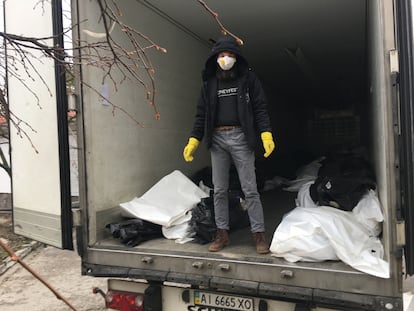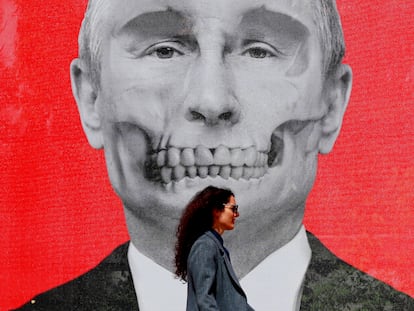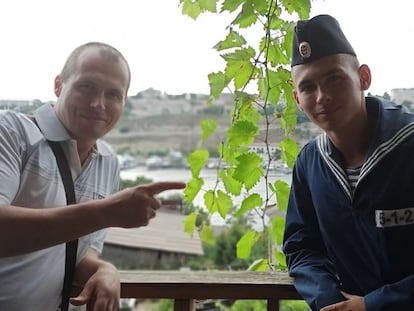The Ukrainian artist who whispers to the dead
A morgue on the outskirts of Kyiv became the frontline of the war for a pacifist volunteer

The war in Ukraine creates strange bedfellows. That’s what Spanish former porn actress and artist Amarna Miller might think when she finds out that a Ukrainian artist is going to use her 2015 book, Manual of Psychonautics, as inspiration for a project based on his experiences as a morgue volunteer. “She represents Eros; I represent Thanos,” says Aleksander Krolikovski as he eats some pizza while looking at his photos of mangled corpses and pools of blood. Krolikovski is striving to transcend the eternal tension between pleasure and pain as he works in the shadow of a war that threatens the very survival of his country. As he speaks about his wartime experiences, his words express tender feelings of solidarity and then switch unexpectedly to gory anecdotes. “Sometimes I had to step on bodies to move around the morgue, so I’d quietly apologize to them. It was terrible – there were so many of them…”, he said, lowering his voice to a whisper to demonstrate how he apologized to the dead.
Krolikovski was recovering from the lingering effects of a bout with Covid-19 when Russian President Vladimir Putin ordered the invasion of Ukraine on February 24. Krolikovski has absolutely no military experience and describes himself as a “pacifist.” But he quickly agreed to lead a team of volunteers to help the war effort far from the front lines. But there are many fronts to this war. One day, help was needed at the morgue, but none of the volunteers was up to the task. So Krolikovski went to the morgue himself and stayed there for almost a month. “The worst part was showing the bodies to the families. I empathized a lot with the families and shared their pain. Sometimes I had to warn them, “There’s no head.”
We interview Krolikovski a few weeks after his experience in the morgue, with the Russian troops far from Kyiv. His creative streak emerges as he talks about the photos he took with an instant camera in the Vyshhorod Hospital morgue, north of Kyiv. He spreads the photos on the restaurant table and picks them up, one by one, as if they were playing cards. For him, the photos bridge the gap between modernism, postmodernism, and the obscurantism of his invaded country. He pauses to talk about one of the first pictures he took with his Instax – a pair of boots, the ones he would put on to go inside the refrigerated trailer used for the overflow from the morgue. These “boots of blood,” said Krolikovski, are the most recent manifestation of the boots painted by Vincent Van Gogh in 1886, and the shoes photographed a century later by Andy Warhol with his Polaroid camera, the ancestor of the Instax.
A crash course alongside Ukrainian and French forensic teams gave him a working knowledge of the various types of wounds and weapons. “The bodies that came from a mass grave in Bucha had a huge impact on me. They showed signs of torture… their eyes had been gouged out by a red-hot metal tool. I could even understand being shot, but for the Russians to do that… I don’t understand it,” he says. “Even the doctors had never seen that kind of torture.”

Anyone who has been to a morgue in a war zone knows that Krolikovski could have taken even more gruesome photos. He talks about the carnage with a certain detachment, but he clearly tried to humanize the dead by treating them as if they were still alive. “I talked to the dead… it helped me cope. I felt ashamed to be among them–it was awful. I would say over and over, ‘I’m sorry, I’m sorry’.” Krolikovski’s demonstrates how he walked through the piles of corpses trying to avoid stepping on them. “Sometimes I’d come in and say, ‘Guys, I have some news. I’m bringing you a gift – new body bags, white ones. I’m going to exchange them for your old, black ones.’ White is better, more fashionable.” As he says this, it sounds considerate and not at all offensive or frivolous.
Day in and day out, the dead kept coming into the morgue, and with them the task of identifying the bodies and investigating the deaths. Some ended up becoming part of Krolikovski’s morgue “family.” The police would come looking for a specific body, and Krolikovski would respond, “Number 173? Yes, the beautiful woman over there. 180? Sure, the athletic, healthy-looking man. We always tried to be respectful,” he said. He remembers when the victims began flooding in. “It’s very tough, physically. Carrying them, bringing them in… we had to leave them outside sometimes when there was no room in the morgue or the trailer.”
Krolikovski was born 39 years ago in Donbas, the eastern Ukraine region almost completely controlled by pro-Russian separatists, where hundreds of people are dying every day as the war rages on. He later moved to Crimea to take art classes. When Russia illegally annexed Crimea in 2014, Krolikovski moved to Kyiv just as pro-Russian president Viktor Yanukovych was ousted from office in the Revolution of Dignity. “I rejected the Russian propaganda and fell in love with that movement in Kyiv,” he says.
He always tries to draw lessons from his experiences and remains optimistic. “I hope that all this will help us all realize that death is real, and that people shouldn’t be so cruel. There is a lot of evil in our lives. The Russians must have had hell inside their heads… to do all of this.” During our interview, Krolikovski never stops directing his team of volunteers. It seems that he has emerged unscathed from his intense experience in the morgue. But he hasn’t. Living so close to so much trauma and death will take a toll on anyone, especially someone who has never been exposed to those conditions. Krolikovski readily admits, “A part of me died in the war. I’m a totally different person now. It wasn’t just the morgue… it’s also the rapes and the tortures… I’m not the same.”
Tu suscripción se está usando en otro dispositivo
¿Quieres añadir otro usuario a tu suscripción?
Si continúas leyendo en este dispositivo, no se podrá leer en el otro.
FlechaTu suscripción se está usando en otro dispositivo y solo puedes acceder a EL PAÍS desde un dispositivo a la vez.
Si quieres compartir tu cuenta, cambia tu suscripción a la modalidad Premium, así podrás añadir otro usuario. Cada uno accederá con su propia cuenta de email, lo que os permitirá personalizar vuestra experiencia en EL PAÍS.
¿Tienes una suscripción de empresa? Accede aquí para contratar más cuentas.
En el caso de no saber quién está usando tu cuenta, te recomendamos cambiar tu contraseña aquí.
Si decides continuar compartiendo tu cuenta, este mensaje se mostrará en tu dispositivo y en el de la otra persona que está usando tu cuenta de forma indefinida, afectando a tu experiencia de lectura. Puedes consultar aquí los términos y condiciones de la suscripción digital.
More information
Últimas noticias
Sinaloa Cartel war is taking its toll on Los Chapitos
Venezuela hardens its ‘revolutionary state’ project amid pressure from Trump
Sydney Sweeney, the actress praised by Trump: ‘Women are up against what society wants them to be’
The Bolsonaro surname: An advantage or liability in Brazil’s 2026 presidential elections?
Most viewed
- Reinhard Genzel, Nobel laureate in physics: ‘One-minute videos will never give you the truth’
- Pablo Escobar’s hippos: A serious environmental problem, 40 years on
- Charles Dubouloz, mountaineering star, retires at 36 with a farewell tour inspired by Walter Bonatti
- Why we lost the habit of sleeping in two segments and how that changed our sense of time
- The fall of a prolific science journal exposes the billion-dollar profits of scientific publishing










































